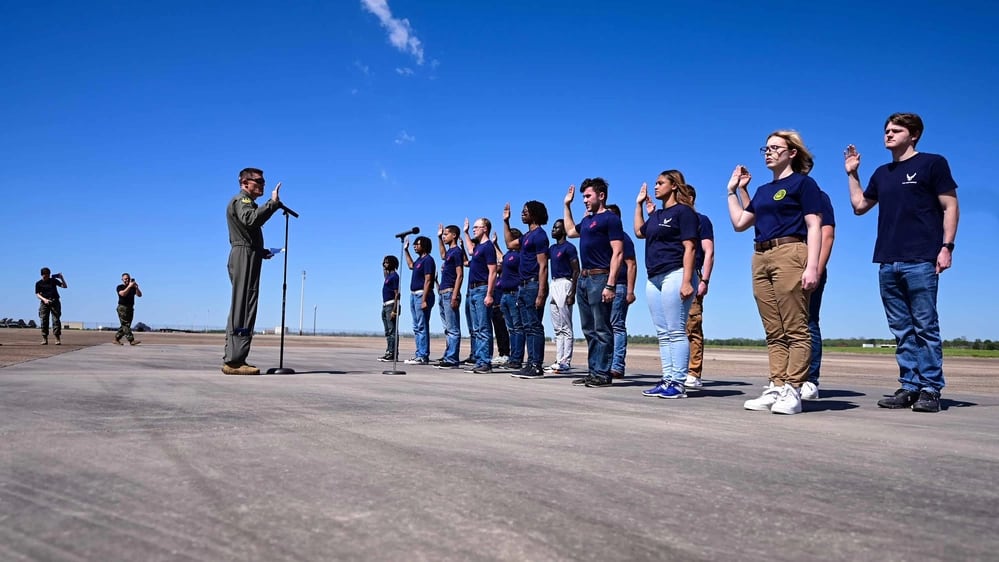WASHINGTON — The U.S. Air Force is expanding its partnership with a professional drone-racing league that touts a tech-savvy fan base, which leaders believe will likely engage with and potentially enlist in the military.
The Drone Racing League’s 2023-2024 season will for the first time feature an Air Force-endorsed pilot and flight deck, capping seven years of growing collaboration. An inaugural STEM day is also planned, during which children and young families can learn about tinkering and piloting.
The exposure to science, technology, engineering and mathematics — key to twitchy, physics-based drone racing — could help shape future airmen, the service argues.
Military recruitment efforts have struggled for years: The Army missed its fiscal 2022 recruiting goal by roughly 15,000 new soldiers, and the Air Force this year is expected to fall about 10% short of its own target. The reasons vary: Fewer Americans are meeting basic fitness standards, a healthy job market is luring candidates away from signing up and overall confidence in public institutions has sharply contracted.
Brig. Gen. Christopher Amrhein, the commander of the Air Force Recruiting Service, told C4ISRNET that the Drone Racing League’s patrons are part of an ideal pool from which to seek recruits.
“The competition is spectacular, the content is immersive and educational, and the league engages a coveted audience of young, high-energy tech-setters who have a passion for flight, innovation and technology,” he said July 26. “They are future U.S. Air Force recruits and airmen, and a core reason why we continue to renew our partnership with DRL year after year.”
What does the league do?
The Drone Racing League defines “tech-setters” as 16- to 34-year-olds not attracted to legacy sports like football, baseball and basketball. Instead, the demographic gravitates toward technology, competitive gaming and simulation.
The DRL racing premise is deceptively simple: A pilot must maneuver a drone from a first person point of view through an obstacle course as quickly as possible and in competition with other fliers. Points are dished out based on results.
Competitions are held in stadiums across the globe and in the virtual realm, via the DRL Simulator, a realistic video game.
The DRL Simulator already features an Air Force workbench, where players can construct custom racing drones, and the Air Force Boneyard maps, where players can zoom through a deserted airport in the daytime or darkness.
The league’s metrics show more than 80% of fans favor collaboration with the Air Force, a long-standing partner. Internal data also shows fans are 30 times more likely to engage with the service on social media channels. Previous races logged 260 million global streaming views.

“Really from day one, we’ve seen this endemic fit of the Air Force wanting to recruit the best and brightest,” DRL President Rachel Jacobson told C4ISRNET in an interview. “When you look at this tech-setter audience that we call our fans, you see that they are wired to love technology, innovation, engineering, precision, sports — all of these areas that have become valuable skill sets for the Air Force.”
Interest in drones has ballooned in recent years alongside their prevalence within militaries, police departments and hobby groups. The global commercial drone market is expected to reach $38 billion by 2027, according to Statista, a data-gathering and analysis firm.
As the U.S. military increasingly leans into uncrewed technologies, it will require well-versed engineers, technicians and remote pilots. Such a cohort is familiar to the Drone Racing League.
“As a technology-powered sport, STEM is at the heart of everything we do. It’s literally the beating heart of DRL,” said Jacobson, a former NBA business development executive. “From the drones to the radio networks, our expert engineers are hand-developing every piece of technology that makes our high-speed drones available.”
Colin Demarest was a reporter at C4ISRNET, where he covered military networks, cyber and IT. Colin had previously covered the Department of Energy and its National Nuclear Security Administration — namely Cold War cleanup and nuclear weapons development — for a daily newspaper in South Carolina. Colin is also an award-winning photographer.








